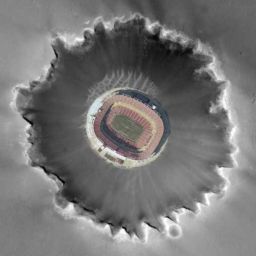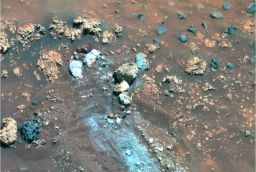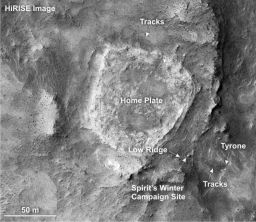A.J.S. Rayl • Jun 30, 2007
Mars Exploration Rovers Update: Spirit Detours in Silica Valley, Opportunity Returns to Duck Bay to Enter Victoria
The Mars Exploration Rovers (MERs) spent the month of June finishing work and clearing their agendas at their respective locales at Gusev Crater and Meridiani Planum in preparation for highly anticipated new assignments in July.
The big Mars news this month came from Earth during a NASA press conference on Thursday, June 28, 2007, when officials announced that Opportunity would be venturing into the 800-meter (half-mile) diameter crater called Victoria early in July. Since the impact that created Victoria billions of years ago effectively dug deep into the ground, the rover will be traveling farther back in time to ancient environments of Mars. It's a trek, however, that carries real risk for the aging robot field geologist.
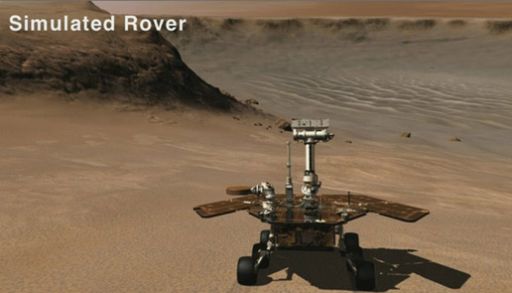 Opportunity ready to roll
Opportunity ready to rollThis image shows a simulated Opportunity ready to descend into Victoria Crater via the rock-paved slopes of an alcove dubbed Duck Bay. If all goes according to plan, the rover will take it first roll in on July 7 or 9, 2007. Inside the crater, the rover will examine the deeper, older rocks that might hold clues to Mars' wet past. Duck Bay has slopes of about 15 to 20 degrees and exposed bedrock, making it the safest site for entry. Credit: NASA / JPL / Cornell Click here for animation.
"We are now more than 1200 sols into our mission and we're about to embark on a completely new phase in this adventure," Steve Squyres, of Cornell University, the principal investigator for rover science, told the media that assembled via teleconference. "The beauty of Victoria Crater is that after it formed, it got bigger in diameter and, as it grew, it eroded from busted up rubble into intact bedrock. What we see in the promontories and even up some of these slopes is an intact, beautifully preserved record without all this crater-induced jumbling of the bedrock. It provides the clearest, cleanest, best-looking, deepest record of the geology at Meridiani Planum we've seen anywhere along the rover's entire traverse."
Opportunity first pulled into Victoria more than 250 sols ago, in September 2006, and since then has been driving to the northeast around the scalloped rim of the crater surveying the geology in the crater walls and looking for a way in. Just days ago, however, it returned to its startpoint. "Duck Bay, the first place we arrived at, turns out to be the best place to go in," said John Callas, MER project manager at the Jet Propulsion Laboratory (JPL), the rover's mission control. After some nine months of exploring the crater from the rim, the rover is slated now to begin its journey down the crater slope, he said, as early as July 7 or July 9.
"Entering this crater does come with some unknowns," warned NASA associate administrator, Alan Stern, of NASA Headquarters, who made the official announcement that the agency had approved the MER team's proposal. "We are leaning forward with our risk posture." It wasn't really a close call, he said later. The rover team made "a convincing case," and considering that the mission has gone three years and three months beyond its 90-day primary mission, chalking up "great successes" along the way, even if Opportunity wound up stuck in the crater, "the risk is worth the reward," Stern said. "This is an example of a rover pushing far beyond what anybody in their wildest imagination ever expected we could do."
"Everyone at JPL, on our science team, and at NASA Headquarters, felt that if we were ever going to do this the time was now," Squyres added. "The kind of stuff we want to do inside this crater really requires a healthy six-wheeled rover, which is what we have now. We're interested in getting in there, doing our business, and getting out while the vehicle still has those six wheels to enable us to climb out. Then we've got a lot more science to do on the plains around the crater," he said, noting that the scientists already have their eyes on the cobbles and other deeply eroded craters like Erebus back out on the plains. "But now is the time to enter Victoria Crater."
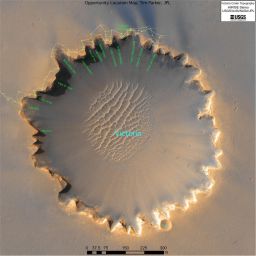 Opportunity's tour of Victoria's rim
Opportunity's tour of Victoria's rimThis image -- taken by the High Resolution Imaging Science Experiment (HiRISE) camera onbaord the Mars Reconnaissance Orbiter (MRO)-- shows the "coves," promontories, and "bays" that Opportunity has been studying for the last 8 months.Credit: NASA / JPL-Caltech / Univ. Az / USGS/ T. Parker
The first science objective on Opportunity's new mission is to investigate a band of bright material that encircles the interior of the crater like a "bathtub ring," as Squyres described it. "That bright band somehow formed very long ago under what could have been different environmental conditions and so we really seek to understand here how that formed and whether or not it could reveal something about what the Martian environment was like back when the crater formed."
The announcement that Opportunity will enter Victoria comes just weeks after Spirit reclaimed the spotlight with rather remarkable findings this deep into its investigation of the Columbia Hills area of Gusev Crater.
In early May, the MER team reported Home Plate to be the first explosive volcanic deposit identified on the mission with "a high degree of confidence" and, a week or so later, announced Spirit's landmark discovery of nearly pure silica, in a target named Gertrude Weise, what Squyres calls one of the Top 5 finds to date.
Spirit then turned to rove up Home Plate from the northeastern end, with planned stops on the way up to check out various layers in the rock there. It completed the requested inspection of the layers of rock in the slope leading to the top of the circular plateau in a matter of days. But when new data from the mini-thermal emission spectrometer (Mini-TES) revealed more silica-rich targets not far from Gertrude Weise, the team decided that the rover should to take a detour back into newly named Silica Valley to check them out.
Spirit spent the rest of June in the Silica Valley, which separates Home Plate from Mitcheltree Ridge, and is currently finishing its research there now, according to Ray Arvidson, deputy principal investigator for rover science, the Washington University St. Louis geologist who is overseeing science operations on this rover. "The big news from Spirit this month comes in the high silica deposits we're finding as outcrop right at the distal edge of the periphery of Home Plate and in Mini-TES observations wherein we actually see water molecules in the rocks," Arvidson said in an interview earlier this week. As Opportunity begins its descent into the big hole in the ground, the plan now for its alpha twin is for it to -– "honest to God, blood pact," said Arvidson -- make its ascent onto Home Plate, where it will look for more evidence to bolster the team's eroded-over volcano hypothesis.
If it seems as if Opportunity has once again stolen the spotlight, it has. However, Spirit is still the trooper, forging ahead as always, consistently returning stunning findings. "Spirit in its own way is finding evidence for water interacting in the crust, but it is long into the mission, it took the mobility, and it's finding evidence at a scale that's too small to see from orbit," Arvidson pointed out.
While the hematite –- a mineral that usually forms in water on Earth –- was observed from orbit in Meridiani Planum long before Opportunity roved into those billions of little "blueberries" or tiny spherules that dot the plains, we'll "never see Silica Valley from CRISM," because I've looked," added Arvidson, who is also a member of the MRO's Compact Reconnaissance Imaging Spectrometers for Mars (CRISM) team. "The outcrops only occur over a meter or so and a CRISM pixel is 18 meters," he explained. "But, with Spirit roaming around older terrains down on the surface, the indication is anywhere you go, you're going to find a complex, geological history that involves water."
Perhaps the greatest news from Mars this month, though, is the fact that both Spirit and Opportunity –- which were designed to complete a 90-day primary mission -- are still in good health, with all instruments still functioning, and are both now sporting robust power levels. Opportunity has been repeatedly getting its solar arrays blown cleared of dust by little gusts of wind, but for Spirit, the last time the Martian wind did it a favor was in 2005. Truth told, there has been some real concern about this rover's energy levels during the past year. This month that changed in a big way for MER-A as its power levels jumped up past 730 watt-hours. Considering that, "right off the showroom floor," as Callas put it, the rovers boasted power levels of around 900 watt-hours, one can only marvel about Spirit's newfound energy.
Despite these repeated "second winds," both Spirit and Opportunity are showing the signs of their old age and they face an uncertain future with every passing day. All the great engineering, luck, and incredible resilience aside, the rovers are, after all, robots and they will eventually break down. Team members long ago adopted an "anything can happen any day" attitude, viewing at each day as a bonus to an already legendary mission, knowing only too well that their two charges have been roving around in extreme temperatures since landing back in January 2004. It seems something of a miracle that the only real failure of the mission so far is Spirit's loss of its right front wheel although Opportunity's instrument heater has been stuck in the "on" position since shortly after landing and, more recently, it has been occasionally struggling with an arthritic instrument deployment device (IDD) or arm.
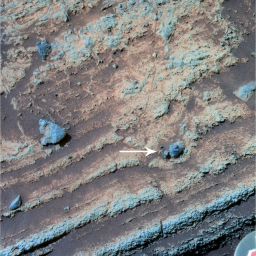 Home Plate up close
Home Plate up closeSpirit took this false color image of an edge of Home Plate with its Pancam. It shows some of the evidence on which the science team is basing its hypothesis that the circular plateau was created from volcanic activity. The lower coarse-grained unit shows granular textures toward the bottom of the image and massive textures. A feature interpreted to be a "bomb sag," which is 4 centimeters across, is pointed out.
Credit: NASA / JPL-Caltech / USGS / Cornell
Near the Martian equator, where Spirit and Opportunity are exploring opposite sides of the Red Planet, the highs and lows they experience are dramatic. So far, the rovers have recorded temperatures ranging from midday highs of about 95 degrees Fahrenheit (35 degrees Celsius) in spring and summer to nighttime lows of minus 166 degrees F (about minus 110 degrees C) in winter. Spirit has experienced greater temperature swings, because its location is farther from the Martian equator, where sunlight is seasonally either more direct or less direct than at Opportunity's location.
Both rovers have lost a few temperature sensors though dozens more continue operating, but, more significantly at the moment, their internal electrical connections and moving parts are showing signs of temperature-related fatigue. "Every day, we have a huge thermal cycle," Jake Matijevic, chief of the rover engineering team, noted earlier this month. "That causes the solder in electrical connections to expand and contract until it breaks." Engineers have traced the stalls in Opportunity's shoulder joint motor on its IDD to a broken electrical wire. Its location beside the heater that has been stuck "on" position, the shoulder motor has experienced, it turns out, greater temperature swings than other parts. "Our theory is that one of the wires in the electrical coil broke free and disabled the motor," Matijevic offered. The rover planners (RPs) have compensated for Opportunity's arthritic shoulder joint by unstowing it before going to sleep at night. This way, if the motor fails during the night, when temperatures are at their lowest, they would still have limited use of the arm by operating the remaining working joints.
Extremely cold temperatures have also caused mechanical problems. Recently, Opportunity's right front wheel began drawing excess electrical current. This is achingly reminiscent of Spirit's right front wheel in 2004. The demand for more electrical current suggests that the wheel motor is working harder than usual. In the case of Spirit, engineers suspect that, like motor oil that can't handle freezing temperatures on Earth, the gel lubricant failed to flow properly and that caused its right front wheel to fail. Rover drivers have compensated for Spirit's lame wheel by driving on the other five wheels, but the loss has affected the rover's mountain-climbing ability. And, if Opportunity's wheel fails while it is conducting its work inside Victoria, it could mean the end of its record-breaking roving.
As springtime has settled in on Mars' southern hemisphere, warmer temperatures are making things a bit easier for the MERs. But spring also brings highly unpredictable Martian dust devils and duststorms. In fact, a regional dust storm, covering a very broad area primarily to the south of Opportunity's location, has kicked up the tau and increased the opaqueness in the atmosphere above Meridiani. "We've been tracking it with our friends on the Mars Color Imager [MARCI] team on the Mars Reconnaissance Orbiter (MRO) and they have provided us lately with daily weather updates," said Squyres. "If past experience is any guide, it may be starting to blow itself out, but that is just a guess. We don't have good predictive power for Martian weather. We don't know what this storm is going to do. It could grow and do nasty things to us. The good news is that we are expecting to be able to operate Opportunity even under very dusty conditions at the present time, because its solar arrays happen to be very clean."
 A dust devil swirls by Spirit
A dust devil swirls by SpiritOn Sol 1120 (Feb. 26, 2007), Spirit used its navigation camera to capture one of the best dust devils it's seen in its three-plus year mission. The series of navigation camera images were put together to make this movieclip. The dust devil column is clearly defined and bent in the down wind direction. Near the end of the movie, the base of the dust devil becomes much wider. The atmospheric science team thinks that this is because the dust devil encountered some sand and therefore produced a "saltation skirt," an apron of material that is thrown out of the dust devil because it is too large to be carried up into suspension. The little devil also seems to move faster across the surface near the end of the clip. This is because the rover began taking pictures less frequently, not because the dust devil sped up. Credit: NASA / JPL-Caltech
For now, the rovers -– which, interestingly, only have about 1/100th the processing power of a decent desktop computer -- continue to keep on keepin' on, returning science as exciting and fresh as when they first began, oblivious to the concern that constantly surrounds them. Spirit and Opportunity are each in their fourth extension and funded are funded to the end of NASA's fiscal year, October 1, 2007. Even as the unknown is ever-present, the team awaits the decision on their application for a fifth mission extension that would keep the dynamic duo roving to October 2008.
Spirit From Gusev Crater
Following its study of bright, nearly pure silica soil deposits dubbed Kenosha Comets, at a target known as Gertrude Weise, in May, Spirit drove to a perch on the northeastern edge Home Plate and began studying its stratigraphy or layers leading up to the top of this circular formation. There, it homed in for detailed inspections of a lower layer target dubbed Pesapalo and a rock target called Supespesis on a fin-shaped piece outcrop. The plan had been for the rover to then climb onto of Home Plate. But those plans would change.
 Spirit's view of Home Plate Sol 746
Spirit's view of Home Plate Sol 746Spirit discovered Home Plate, which the MER science team now believes is the remnant of volcanic activity, looked more like the layered rocks of Opportunity's landing site than anything it had previously encountered at Gusev.Credit: NASA / JPL / Cornell / Tesheiner
Throughout the month, Spirit continued conducting its routine atmospheric studies, checking the tau or dust level in the atmosphere with the panoramic camera (Pancam), taking surveys of the sky and ground using the miniature thermal emission spectrometer (Mini-TES), and scanning the sky for clouds using the navigation camera. It also frequently monitored its solar arrays for dust accumulation, searched for dust devils with its cameras, and occasionally used the alpha-particle X-ray spectrometer (APXS) to look for argon in the atmosphere. The rover also kept its daily communications schedule, from its morning wake-up call direct-from-Earth via the rover's high-gain antenna to the regular evening downlinks of data at UHF frequencies via the Mars Odyssey orbiter.
With its power levels soaring, Spirit packed in the ground-truthing science in June. It began the month on Sol 1212 (June 1, 2007) by continuing its detailed study of June Emerson with the Mössbauer spectrometer, taking some microscopic imager (MI) pictures of rock targets called Dorothy Key and Betty Foss, and checking out the mineral make-up rock targets known as Helen Staubin and Dorothy Chapman with the Mini-TES. In the sols that followed the rover continued Mössing June Emerson, and used the Mini-TES and the Pancam to checkout targets dubbed Joan Chiancola, Jaynie Krick, Jean Gilchrist, Irene Kotowicz, Audrey Seitzinger, Lucille Colacio, Mary Kustra, Clara Cook, and Ruth Lessing, all named for former players in the All-American Girls Professional Baseball League, in accordance with the chosen baseball theme.
On Sol 1215 (June 4, 2007), Spirit drove 1.2 meters (3.9 feet) to a finely crossbedded rock target dubbed Elizabeth Emery, acquired the usual post-drive navigation camera images, surveyed the horizon with the Pancam, and did some more general reconnaissance of the immediate surrounding area with the Mini-TES.
The rover focused on Elizabeth Emery for the next several sols, brushing it with the rock abrasion tool (RAT), then looking at it up close with the MI, and APXS, and the Mössbauer spectrometer to determine its composition.
Spirit turned on Sol 1217 (June 6, 2007) to brush a finely crossbedded rock target known as Jane Stoll, which it then snapped with the MI, before continuing to determine the iron content of Elizabeth Emery with the Mössbauer. The next sol, Spirit used the RAT to brush the surface of rock targets dubbed Mildred Deegan and Betty Wagoner, then took MI pictures of the brushed surfaces, and later acquired images of a target known as Donna Cook with the Pancam.
Spirit's straigraphy study on the slope leading up to Home Plate continued into the second week of June, as the rover brushed a rock exposure adjacent to Betty Wagoner, nicknamed Betty Wagoner's Daughter with the RAT, then took a mosaic of MI pictures, touched the target with the Mössbauer spectrometer, and acquired more pictures with the Pancam, before putting in some time watching for dust devils.
On Sol 1220 (June 9, 2007), Spirit acquired full-color, Pancam images of targets known as Melba Alspaugh, Helen St. Aubin, and Ruth Lessing, then switched to the Mini-TES to assess the composition of Melba Alspaugh2, Betty Whiting2, Joan Chiancola, and Helen St. Aubin2, and to take another measurement of Jean Gilchrist. The rover completed its research on the Home Plate slope, packed up, and headed out the next sol, but not for the top of Home Plate as planned. Rather, it scooted down the slope and headed back into the Silica Valley to another target called Nancy Warren.
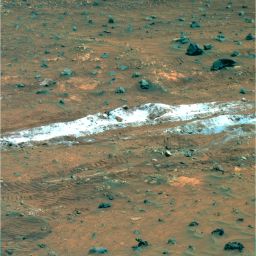 In the Silica Valley
In the Silica ValleySpirit shot this false color image looking toward Silica Valley on Sol 1213 (June 2, 2007)with its Pancam. The false color enhances some of the silica-rich soils the rover has been studying in the little Valley between Home Plate and Mitcheltree Ridge.Credit: NASA /JPL-Caltech / Cornell
"We took a detour," Arvidson said. "We finished the work going caddy-corner up the Home Plate slope, then decided to go back and finish up Silica Valley properly, because Steve Ruff [Arizona State University] and the Mini-TES had found new high-silica candidates. This is a mission of exploration and discovery and we responded to the remote sensing discoveries and decided to capitalize on our abilities to make multiple measurements on targets," he said. "As much as we're all anxious to get on to Home Plate proper, we realized in looking at the data we collected in the Silica Valley that we wanted to go back because there were these other high silica targets, including Nancy Warren, that were easy to get to."
So, after completing its studies of rock exposures Elizabeth Emery and Betty Wagoner, Spirit drove down the Home Plate slope and back in the direction of Gertrude Weise to the outcrop called Nancy Warren. As it turns out, the new target appears similar to the previously studied outcrop Elizabeth Mahon, which was composed of approximately 72% silica. After completing a reconnaissance study its tracks with the Mini-TES on Sol 1223 (June 12, 2007), the rover turned the instrument toward Nancy Warren for one more look, then approached the target, acquiring the usual post-drive image mosaics with the navigation camera after the short drive.
After moving in close, Spirit used the MI, the APXS, the brush on the RAT, and the Mössbauer spectrometer to analyze the latest silica candidate. Science teams members now believe that a layer of dark soil on Elizabeth Mahon likely affected the measurement of silica content with the APXS, which measures the abundance of chemical elements. Since Nancy Warren appears to have less of the dark soil coating than Elizabeth Mahon, "she" could help scientists characterize the silica found at Gertrude Weise.
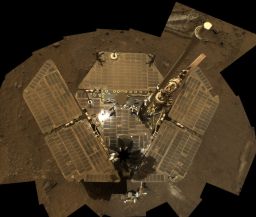 Spirit's freshly cleaned deck
Spirit's freshly cleaned deckIs this cool or what? Spirit used its panoramic camera (Pancam) to take the images combined into this third mosaic view of the rover in the sols following a dust-cleaning event, on Sol 1224 (June 13, 2007). The downward-looking view omits the mast on which the camera is mounted to show that much of the dust that normally accumulates on the rover's solar panels has been "cleaned" off the deck. The images were taken through the camera's 601nm, 535nm and 482nm filters on Sol 1229 (June 18, 2007) and put together by Pancam principal investigator Jim Bell. Not surprisingly, Bell picked this as his favorite image from Spirit this month.
Credit: NASA /JPL-Caltech / Cornell
Luck blew in on the Martian wind for Spirit on Sol 1224 (June 13, 2007). While the rover was conducting general reconnaissance with the Mini-TES, it finally got a much-needed spring-cleaning that increased power from its solar arrays by 120 watt-hours, pushing the rover's energy into a really comfortable zone above 600 watt-hours, and bestowing it with a real "second wind." It had been a long time coming. The last time this rover experienced dust-lifting winds was in 2005.
"This [dust-cleaning event] was interesting, different from cleaning events we've had in the past," Squyres said in an interview in his office at Cornell, two days after it happened. "In the past, we've had cleaning events that took place when we were on a summit or a ridgecrest and in the past they have sometimes occurred at night. The rover will shut down in the afternoon with dirty solar panels and wake up in the morning with clean solar panels and we have no idea exactly when it happened. In this particular instance, the rover was awake and busy and active when the event happened so we can pinpoint the timing of it. It happened at 1:20 pm in the afternoon local solar time. Of course, we are now down on a low spot, not up on a ridgecrest of anything. So our speculation –- this is pure speculation at this point – but our speculation is that we took a direct hit from a dust devil. We don't know that. But we are in place where dust devils happen and it's prime time for dust devil activity, the time of day when dust devils seem to be most active."
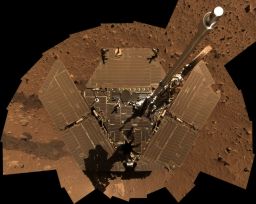 Martian dust in the wind -- and on the rover
Martian dust in the wind -- and on the roverSpirit used its Pancam to take the images combined into this mosaic view of itself. As in the "cleaned deck" picture above, the downward-looking view omits the mast on which the camera is mounted. In this image, however, you can easily see the dust accumulation on the rover's solar panels. The images were taken through the camera's 601nm, 535nm and 482nm filters during Sols 329 and 330 (Dec. 7, 2004).
Credit: NASA /JPL-Caltech / Cornell
"It is plausible," agrees Arvidson. "But really not testable. Since the Mini-TES was opened when it happened, Ruff and his team are still evaluating whether the dust on the mirrors have changed, but we're still getting reasonable spectra." The only way they could tell if we were hit with a dust devil, short of somehow capturing signs of the devil with one of the cameras, he noted, is to look at HiRISE data after the cleaning event, note where the vehicle was, and see whether or not there is a new dust devil track. "Otherwise it would be very difficult to understand whether it was wind gust or actual turbulence due to a dust devil passing by."
An energized Spirit unstowed its IDD on Sol 1225 (June 14, 2007), acquired a mosaic of MI pictures of Nancy Warren, then placed the APXS on the target to take more compositional readings.
In the sols that followed, Spirit continued its study of Nancy Warren. On Sols 1226, 1227, and 1228 (June 15-17, 2007), the rover worked on a second investigation that was intended to study a brushed surface of the rock by taking another MI mosaic and more readings with the Mössbauer spectrometer. Alas, this time the rover did not complete the brushing operation, so it ended up taking a second set of measurements that turned out identical to the first. Its time wasn't all wasted, however. Spirit did take images of the spacecraft deck with the navigation camera and Pancam, requested for obvious reasons after the dust-cleaning event of Sol 1224, as well as some Mini-TES surveys of new targets dubbed Patricia Courtney, Lenora Mandella, Barbara Rotvig, Pauline Crawley, Shirley Crites, Betty McKenna, and Naomi Meier, and a full-color panorama of some light-colored wheel tracks.
On Sol 1229 (June 18, 2007), Spirit continued its analysis of Nancy Warren with the Mössbauer spectrometer and took some more pictures of the spacecraft deck with the Pancam to further document the previous week's dust-cleaning event, following that the next sol with MI pictures of the solar arrays, the dust capture magnet, and the filter magnet, and with Pancam images of the solar arrays. The rover then acquired MI pictures and APXS data on some undisturbed soil near Nancy Warren. Nancy Warren appears to be "both basaltic and high silica," according to Arvidson, and like Elizabeth Mahon, is composed of 70% silica. But it also has some dust contamination and no one can say for sure how much contamination. Members of the science team hope to use data taken from the undisturbed soil to characterize the local soil that might be contaminating the outcrop.
Spirit resumed Mössbauer spectrometer measurements of Nancy Warren on Sol 1231 (June 20, 2007) and surveyed targets Gertrude Weise, Naomi Meier, Rykors, Silian, SithSkeel, Sompus, and Betty Jane Comet with the Mini-TES, while the science operations team regrouped. "We think what's happening is that the disturbed light-toned tracks in Gertrude Weise is just broken-up outcrop," offered Arvidson. "So we decided to try an experiment to break apart what we thought was another chunk of the high silica material. Last week, on Sol 1232 (June 21, 2007), the rover acquired MI pictures of a target called Darlene Mickelson, then attempted the crush experiment on a little rock target called Virginia Bell.
Spirit didn't quite reach Virginia Bell, however, and ended up crunching a soil exposure about 15 centimeters (6 inches) away, creating a new target. "While we intended to crush Virginia Bell, instead most of the damage and breakup was done just to the side of Virginia Bell," Arvidson confirmed. "But it doesn’t matter because we've broken up another rock that looks like Virginia Bell, and that rock is now called Innocent Bystander."
Spirit actually drove, forward, up onto the rock now called Innocent Bystander and moved its lame wheel back and forth. "The mechanism that's broken on the right front wheel is the drive motor, but the azimuth drive, the motor that makes the wheel rotate back and forth, is fine," Arvidson explained. "So we basically got up on the rock and, just like you would grind your heel back and forth, we had Spirit grind its wheel back and forth, then drove back a little bit and repeated it the maneuver, and then drove back about a meter or so to look at what we did." The rover "created fresh rocks surfaces" for the team to analyze," he added.
"Since we didn't have the color data or the Mini-TES data on all these other broken up chunks of rock and we needed that data to see how important these chunks were, we decided after Nancy Warren and breaking up Innocent Bystander to drive to another soil target it previously had disturbed, Eileen Dean, and check that out while we were getting data down to decide what to do on Innocent Bystander. Even before getting the results, however, the team was suspecting that the rover had exposed very fresh, pure rock high silica. "Getting a rock that's 90-92% silica is rare even on Earth and it undoubtedly involves water, other to dissolve everything else away or to emplace the silica, depending on the pH and the oxidation potential of the fluids," Arvidson pointed out.
On Sol 1233 (June 22, 2007), Spirit acquired movie frames in search of morning dust devils using the navigation camera and surveyed the post-crush target area using the Mini-TES. But the sol brought more spring-cleaning as atmospheric turbulence on Mars cleared away more dust from the solar panels. As a result of this most recent dust-clearing event, Spirit out-produced the electrical energy of Opportunity by about 50 watt-hours, the first time that's happened in a long, long, long time, boasting an energy level of 738 watt-hours.
It turns out the Silica Valley has been aptly named. Silica appears to be everywhere. Spirit is currently still sitting over Eileen Dean, which is just about a meter or two away from Nancy Warren and in the same complex," said Arvidson. "You've got this irregular, kind of bumpy looking outcrop that includes Nancy Warren, and then the light-toned disturbed track nearby, which is an area where we saw from a distance with Mini-TES features water-bearing molecules. We can see an actual feature in the Mini-TES spectra that suggests the presence of water molecules, so we're now in the process of deploying the IDD make measurements.
Once Spirit completes the work at Eileen Dean, the plan is for it to drive the few feet back to Innocent Bystander and complete its work in Silica Valley. "Then, after the Fourth of July – honest to God – blood pact – we're going to drive up on to Home Plate," Arvidson promised. "We're done with characterizing the strata of the lip, so next week when we do the ascent it will be a kind of buzz up to the top. Then, we'll get into the bowl proper, heading south by southwest along the top, to look at the structures and the minerals and the textures. It all kind of gets at the origin of Home Plate, which most of us now think is an eroded down volcano, partly generated by a magma interacting with groundwater being charged."
Once up and into Home, the target names will change to " things you put into bowls," Arvidson informed. "We have 350 names, associated with soups, consommés, ice cream, pies, cobblers, and assorted other things you put into bowls. The alternate was names and features of the Dust Bowl in the 1930s," he offered, "but that's pretty much of a downer. Now that we're going to go into Home Plate and since it is a saucer-shaped structure and it's summer and kind of a fun time, we felt food and bowls was a good summer theme." Yum-yum.
Opportunity from Meridiani Planum
For Opportunity, June was all about getting back to where it once belonged -- Duck Bay -- and checking off all the things on its list in preparation for entry into Victoria, the huge, 800-meter (half-mile) diameter crater in Meridiani Planum that it's been exploring from the rim for the last nine months or so.
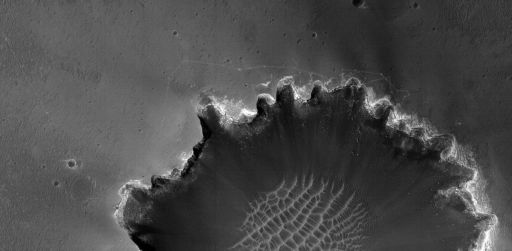 Opportunity's tracks
Opportunity's tracks"The thing I love about this image is the way it so vividly shows what Opportunity's been doing," Steve Squyres, said principal investigator for rover science. "You can see the tracks quite clearly that we have made as we have been traversing along the rim of Victoria Crater. The image was just recently taken by the High Resolution Imaging Science Experiment (HiRISE) camera on MRO. This is actually a subframe of a larger image, which the camera acquired on June 26, 2007. This rover first approached Victoria Crater at an alcove called Duck Bay (see tracks at left), then drove along the crater's sinuous edge in a clockwise direction before heading back. It is expected to enter the crater via Duck Bay in early July 2007.Credit: NASA / JPL / Univ.of Ariz.
Like its twin, Opportunity continued its daily agenda of atmospheric studies and kept to its regular communication schedule, but beyond those routine tasks and completing the last of its new flight software checkouts, the rover spent most of the month with its pedal firmly to the metal. Since the problem with its IDD should joint motor has not gone away, it continues to stow its arm before driving and promptly and unstows it when the drive is finished.
On Sol 1194 (June 4, 2007), Opportunity performed another checkout of its Visual Target Tracking (VTT) technology, drive software that enables it to identify and follow a target, en route to a rock target called Paloma. The checkout tested VTT in combination with other drive software, Autonav and Visodom. The first segment was a blind VTT drive to back away from the target. The rover followed that with the second segment of the drive, which combined VTT and Visodom in a drive that took it 6.8 meters (22 feet) closer toward the target. The rover stopped to take navigation camera images of its tracks, then drove another 30 meters (98 feet) in a third segment that combined VTT and Autonav and directed it right up to the rock. The rover then once again unstowed its IDD and took the usual post-drive navigation camera images and a Pancam image in the drive direction. The rover completed the checkout with the usual flying colors.
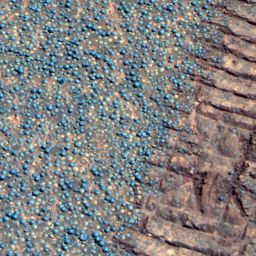 Berries and tracks
Berries and tracksOpportunity snapped this false color Pancam image on Sol 1197 (June 7, 2007). It shows its own tracks and some of the billions of "blueberries" or tiny hematite-rich spherules that the rover has been enountering all around Meridiani Planum . As Pancam instrument lead Jim Bell puts it: "Tracks and berries have certainly been a theme at Meridiani."Credit: NASA /JPL-Caltech / Cornell
In the ensuing sols, Opportunity took thumbnail images of the sky and a morning image of the horizon with the Pancam, conducted its routine atmospheric studies and monitored for dust, as well as conducting regular utility tests on the much-used Mini-TES, in addition to drives on Sols 1196 (June 6, 2007) and 1198 (June 8, 2007). The rover spent most of Sol 1199 (June 9, 2007) on its atmospheric observations.
Although Opportunity had still been on restricted sols at the beginning of the month, meaning it could only drive every other day at best, by mid-June the rover was burning up the Meridiani highway. It still had one more bit of flight software to checkout though. On Sol 1200 (June 10, 2007), the rover drove about 60 meters (197 feet), then executed the fifth and final D-star Global Navigation checkout. This new flight software enhances the rover's ability to autonomously navigate further distances and has been described as giving it the ability to navigate through a maze. Both rover and software once again performed flawlessly and Opportunity managed to check off the last checkout on its agenda. From here on, it was Duck Bay or bust and the rover was raring to go, driving another 12.36 meters (41 feet) autonomously the following sol, after which it took the usual post-drive images with its cameras, and later, after the Odyssey communications pass, looked for atmospheric argon with the alpha-particle X-ray spectrometer (APXS).
On Sol 1202 (June 12, 2007), Opportunity took a few Pancam thumbnail images of the sky, then revved up again and drove 41.56 meters (136 feet) toward Cape Verde, following it the next sol with a 66-meter drive. Opportunity drove south for another 7.84 meters (26 feet) onto Cape Verde on Sol 1204 (June 14, 2007). These mid-month drives flipped the rover's odometer past the 7-mile mark or to 11,369.33 meters to be exact.
At Cape Verde, Opportunity imaged the first half of a stereo image of an area in the middle of Duck Bay. The post-drive IDD unstow, however, stopped short of completion due to an excess attitude change and team members held their breath. "We were doing just a standard IDD unstow and it stopped part way through the unstow process. It scared the living daylights out of us, because this IDD is the one with the problem with the shoulder," recalled Squyres. "We thought something terrible might have happened."
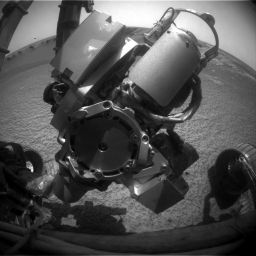 A pirouette -- huh?!
A pirouette -- huh?!This raw, front hazard camera image shows how Opportunity's instrument deployment device (IDD) or robotic arm froze after encountering a bug in the software that made the rover think it had just spun a 360-degree pirouette. "It's not supposed to look like that," says Steve Squyres, rover science principal investigator. "But it is actually kind of a cool picture. I haven't seen that perspective on the IDD since Cape Canaveral. The MI electronics box is still pretty shiny and you can actually see reflections of pieces of the rover. You can even read the serial numbers off the thing and see the Honeybee Robotics logo on the RAT."Credit: NASA / JPL-Caltech
The MER engineers, however, traced the miscalculation to a "bug" in the flight software. "It's been with us since the day we landed, but we had never quite hit the circumstances necessary to trigger it before this," noted Squyres. "It turns out – and this is buried down in the mathematics of some of the attitude software inside the vehicle -- that if the rover is on almost perfectly level ground and it's attitude is within 1/10 a degree of straight south – a heading of 180 degrees plus or minus a tiny, tiny fraction of a degree, then the very small attitude change that can take place when you unstow the IDD can cause the rover to think that it's attitude has suddenly changed by 360 degrees. It goes from +180 degrees to -180 degrees –- and the rover thinks it's done a 360-degree pirouette and it gets terribly confused and just freezes." And that's what happened. Opportunity just froze.
All's well that ends well and since the engineers found the "bug," there are no plans to send up a patch at this point. "We'll just be careful now that we know about this to not let it happen again," Squyres said. On Sol 1205 (June 15, 2007), Opportunity finished up the long baseline stereo image from its position on Cape Verde, then roved on toward Duck Bay, arriving there a few sols ago, where it waited for NASA Headquarters to give it a green light to enter Victoria Crater.
The assessment on Duck Bay as the entry point was based on the slopes, according to MER Project Manager John Callas. "Duck Bay has the shallowest slopes of all the ingress points we surveyed," he said. "The slopes at the entry point are no more than 20 degrees. We know from ground testing and from our experience at Endurance Crater [in 2004] that we can drive the rover as steeply as 32 degrees on clear, hard outcrop, so it's well within the performance envelope of the rover. And, the entry path is fairly clear of loose material and is fairly solid pavement for approximately 100 meters into the crater, so we believe we can traverse that far safely."
Duck Bay is also "power neutral," Callas continued. Since the rovers are solar powered, they rely on the Sun and its position in the Martian sky. Duck Bay's more east-west position allows fewer shadows that could affect the rover's ability to access the sunlight. Moreover, the wide and gently sloping location is also good for communications, either directly to the Earth or commanding to Mars Odyssey, which the mission uses for data return. "Duck Bay presented no complications in terms of available power or in terms of communications," Callas summed up.
 The view from Cape Verde
The view from Cape VerdeOpportunity captured this vista of Victoria Crater from the viewpoint of Cape Verde, one of the promontories on the scalloped rim of the crater. The rover first drove onto Cape Verde shortly after arriving at the rim of Victoria in September 2006. The view combines hundreds of exposures taken by the rover's panoramic camera (Pancam) taken in October and November 2006. The far side of the crater lies about 800 meters (half-mile) away, toward the southeast.Duck Bay is to the right.
Credit: NASA / JPL-Caltech / Cornell
Opportunity's journey, however, won't be without challenges. The first lies between it and its first science objective and comes in the form of a ripple at the northern lobe of Duck Bay. "This ripple is one of the challenges we have with Duck Bay and going into Duck Bay," Callas pointed out. "We do believe the northern lobe is the best entry point, however we have to cross this ripple."
The very word "ripple" can cause engineers to lose sleep. Back in April 2005, Opportunity got seriously stuck in a rippled sand dune, appropriately dubbed Purgatory Dune, and it took the RPs nearly five weeks to extract the roving robot. "So we're actually going to go to the southern end of this ripple, where it is at its shallowest point," said Callas. Opportunity will take "pretty much a straight easterly drive" into Duck Bay, then veer just to the south end of this small ripple. "We'll approach the ripple then drive through or drive onto the ripple if it's safe, then we'll do our toe-dip into the crater."
Although Opportunity's first entrance is being called a toe dip, "it's really both feet and both hands into the crater," Callas said. "We'll take the rover, poised right at the rim of the crater, and drive it one rover length forward so that all six wheels will be on the sloped terrain in Duck Bay. But it will be very close to the rim." This will give the engineers a feel for how the complete body of the rover will behave in this new environment. "Then on that same day," Callas continued, "we'll pop right back out and put all six wheels onto level ground. The, we'll review the data the rover collected before we go in completely and continue the exploration down into the crater."
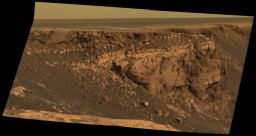 Cape St. Vincent
Cape St. VincentOpportunity took this image of the west face of Cape St. Vincent, one of the many promontories that jut out from the walls of Victoria Crater, with its panoramic camera. The material at the top of the promontory consists of loose, jumbled rock, then a bit further down into the crater, abruptly transitions to solid bedrock. This transition point is marked by a bright band of rock, visible around the entire crater. Scientists say this bright band represents what used to be the surface of Mars before it was impacted to form Victoria Crater. As the rover begins to descend into the crater in early July 2007, it will examine the band carefully at an accessible location with a gentle slope. These investigations might help determine if the band's brighter appearance is the result of ancient interactions with the Martian atmosphere.
Credit: NASA / JPL / Cornell
But first, "like any good explorer," Opportunity and team will check all its equipment before it begins this new campaign, Callas said. Among the housekeeping and engineering activities the rover will complete before going in are calibrating its steering actuators and gyros that monitor the rover's tilt and attitude, all of which are obviously critical to navigating down steep slopes. And of course it will run a checkout of each of its tools.
Opportunity's first science objective can be clearly seen in the image of Cape St. Vincent posted in this Update. One of the promontories along the rim, Cape St. Vincent clearly displays three different geologic units. "The top unit is composed of sand and jumbled up blocks of stuff we call ejecta that was dumped out on the surrounding terrain," Squyres explained. "The lower most unit, which has all that spectacular layering in it, is the bedrock into which the [impact hit] and we suspect there are many interesting stories in that bedrock. But the thing that really caught our eye -- and this is visible all the way around the crater, like a bathtub ring -- is the band of bright material at the very top of the bedrock. It's less than a meter thick and is distinctly bright, weathers differently, and is somehow different from everything else around it."
If you would have had the misfortune of standing on the surface of Mars at Meridiani Planum the day Victoria Crater formed, "your boots would have been right on top of that bright layer right before all those rocks fell on your head," Squyres added. "That was the original pre-impact surface. This bright stuff is the stuff that was in contact with the Martian atmosphere at the time the crater formed, which may have been billions of years ago. So this material may preserve, in its details, information about the interaction of these Martian rocks with the ancient Martian environment," he explained. "We seek to understand here how that formed and whether or not it could reveal something about what the Martian environment was like back when the crater formed. Since this band is visible all the way around the crater, this is not just some local phenomenon. This is a regional thing."
While the image of Cape St. Vincent is ideal for explanation purposes, it's "a little daunting" for Opportunity, because the band there is on a vertical cliff. "While our rovers are quite capable, they cannot climb vertical cliffs," Squyres noted. You can see, however, the same bright band of material exposed on a far slope that's on a tilt of 20, maybe as much as 25 degrees. "These are the kinds of slopes that we know the Opportunity rover can handle," he said. "We drove down slopes that in places reached 30 degrees when we did our extensive survey down in Endurance Crater back toward the beginning of the mission, so we have a reasonably high degree of confidence that the vehicle can handle this sort of terrain."
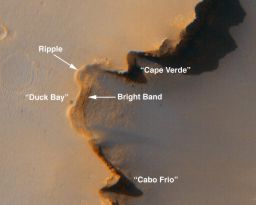 Duck Bay
Duck BayThis image shows Duck Bay, the site where Opportunity will carefully roll down into Victoria Crater. Duck Bay has gradual slopes of about 15 to 20 degrees and exposed bedrock, making it the safest place for the rover to enter the crater. Rover drivers plan to avoid a rippled portion of terrain near the rim of the crater, and to steer Opportunity down the smoothest bedrock with the gentlest slopes.This enhanced-color view was taken by the High Resolution Imaging Science Experiment (HiRISE) camera onboard NASA's Mars Reconnaissance Orbiter (MRO) spacecraft on Oct. 3, 2006.Credit: NASA / JPL / Univ. of Ariz.
From this point at Duck Bay, Squyres said team members "feel confident" Opportunity can enter the crater, traverse down to that bright band, and sample it directly to see what it has to reveal about the ancient environment at Meridiani Planum right before the crater formed. But safety is job #1. "The scientific rules of engagement for this first part of the exploration of the crater go as follows: We are choosing our entry point into the crater solely on the basis of rover safety," informed Squyres. "We are picking the safest place to go in. We will then choose the path that we follow to the bright band again solely on the basis of safety. We're going to find the safest place to go in and the most benign route, the most trafficable route to get to the bright band. We will not deviate from the safest path in order to go after secondary science objectives that might distract us on our way to our primary science objective. However, to the extent that we see good science to be done along the way, we will indeed stop for it."
Whether or not the rover will be able to ascend a given slope depends on two features: how steep the slope is and whether it's made up of mostly rock or sand. "On rocky slope, we have experience that says we can climb rocky slopes as steep as 32 degrees – we've done it," Squyres reiterated. "On a sandy slope though, once it gets much beyond 12, maybe 15 degrees, it gets really hard to climb because you're churning through deep sand." For both the RPs and the scientists, the problem is that it can be very difficult from a distant to differentiate between sand and rock that has a thin and discontinuous layer of sand on top of it. The former the rover may not be able to drive on while the latter it could.
The MER team does know that there are slopes less than 30 degrees all the way down to the dune field at the bottom of the crater. "If that were solid rock all the way down to the dune field, we could go all the way down to the bottom and back out again, no problem," Squyres said. "The problem is once you get past 100 meters into this crater, from the rim it looks like sand. If it's sand, we don't want to venture into it, because the slopes there might be 10, 15 degrees, 18 degrees and we might never be able to climb back up it."
However, at Endurance Crater, the team thought from the rim the terrain inside looked like rock for a short way, then like sand after that. "We decided then we would go in a few meters, sample the rock, and probably turn around and come back out," he recalled. "What happened was, once we got closer, down in the crater and could look ahead, the stuff that looked like sand from up on the rim turned out to be a thin coating of sand on top of bedrock. We could see that in the [newer] images the rover took and that gave us the confidence to continue onward. So I feel very confident that we can go as far as the bright band and do the science that we want to do there. And, I feel pretty confident that should we choose to, we can venture another few tens of meters into the crater on stuff we know to be bedrock. Beyond that, all bets are off. "But we will not venture onto steep sandy slopes unless we have great confidence that right underneath that sand is bedrock," he underscored. "We don't have that confidence now. We'll take a look when we get down there and see what we see."
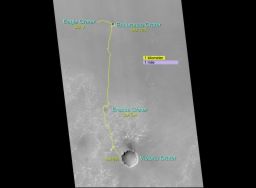 From Eagle to Victoria
From Eagle to VictoriaThis image shows the course Opportunity charted from its landing site at Eagle Crater through Sol 1215 (June 24, 2007) at Victoria Crater. The underlying image is from the Mars Observer Camera (MOC) on the recently decommissioned Mars Global Surveyor orbiter. Click here for animation. Credit: NASA / JPL / Cornell / MSSS /Ohio State University
Although Callas announced July 7 and July 9 as possible dates for Opportunity to do its first toe-dip into Victoria, Squyres, of course, will not predict when it might get to the bright band. "It depends on how much juicy stuff we see along the way," he said. "I've already got people on my team making arguments for things they'd like to stop at, people, in particular, are interested in the ripple [Opportunity must cross]. So we may stop at the ripple and do some compositional measurements before we go in. Then, we'll make the first-ever, good vertical slice through an impact ejecta blanket on another planet."
Beyond the bright band, there are "numerous other possibilities" for targets to investigate inside the Victoria, Squyres said. "The last time we went down into a deep crater was at Endurance Crater, something like 900 sols ago and 6 kilometers away. A number of the processes and a number of the geologic features that we saw at Endurance Crater were of great interest and we simply do not know [if] they were unique to Endurance, a local phenomenon, or if they were a phenomenon that was regional in scale. Now having traversed 6 kilometers and having now found a crater that exposes substantially greater vertical extent of bedrock than at Endurance, we have the chance to investigate those same kinds of phenomena here." At Endurance, for example, the MER team found that the chemistry of the rocks changed as Opportunity went deeper. "We found rocks that had magnesium sulfate dissolved out of them changing their chemistry," Squyres recalled. "This is a consequence of an interaction of water. We want to find out if that was a local or regional phenomenon that included the rocks at Victoria Crater as well."
There are real risks for Opportunity going into the big crater and no one knows for sure if this will be the end of the line for the rover. "We believe we can go in and explore and get out safely, but there is always the possibility that the terrain is different from what we're anticipating," Callas cautioned. "The slips could be excessive, such that it could be very difficult to get back out again. Or we could experience a failure on the rover." That duly noted, he added that the feeling amongst the team members is that this is "an easier adventure" for Opportunity than going into Endurance Crater was. "The initial slopes here are slightly less than at Endurance. We have the benefit of a much more experienced team now and a better understanding of the performance envelope of the rover, plus we have some additional tools available to us in the new flight software. However," he qualified, "it is an older rover now."
Given the resilience of these superbly engineered robot field geologists and the "right stuff" that seems embodied in the metal that makes up their robot bodies, there's every reason to believe.
For all the MER Updates, go to: http://www.planetary.org/explore/space-topics/space-missions/mer-updates/
Support our core enterprises
Your support powers our mission to explore worlds, find life, and defend Earth. You make all the difference when you make a gift. Give today!
Donate

 Explore Worlds
Explore Worlds Find Life
Find Life Defend Earth
Defend Earth


